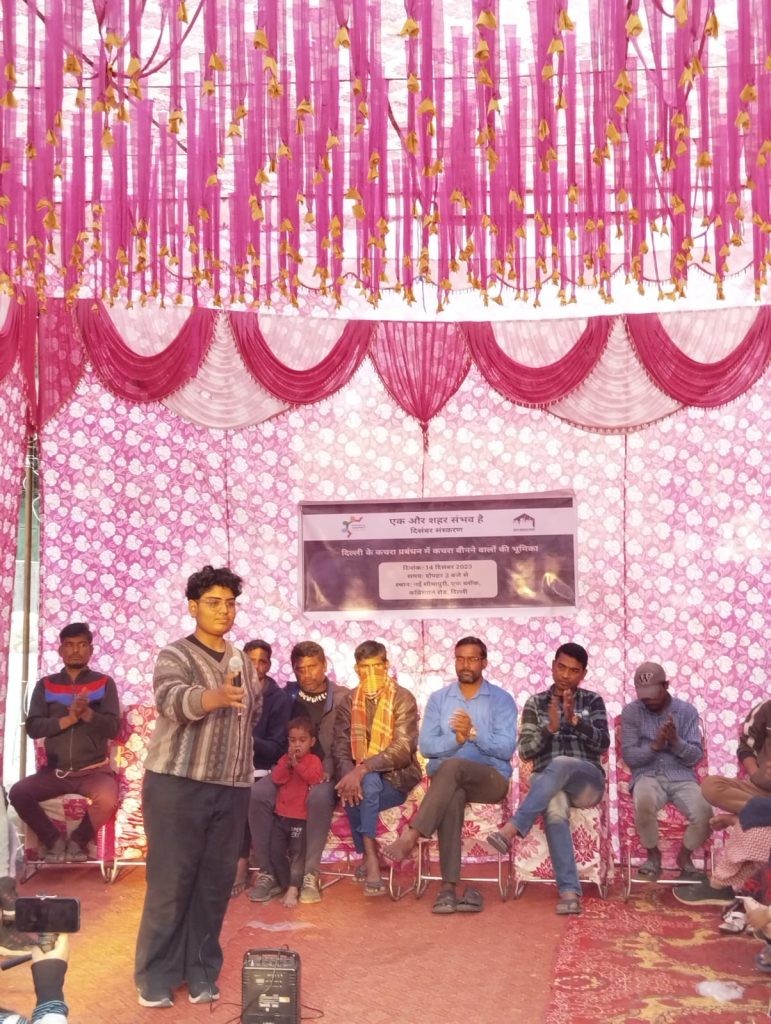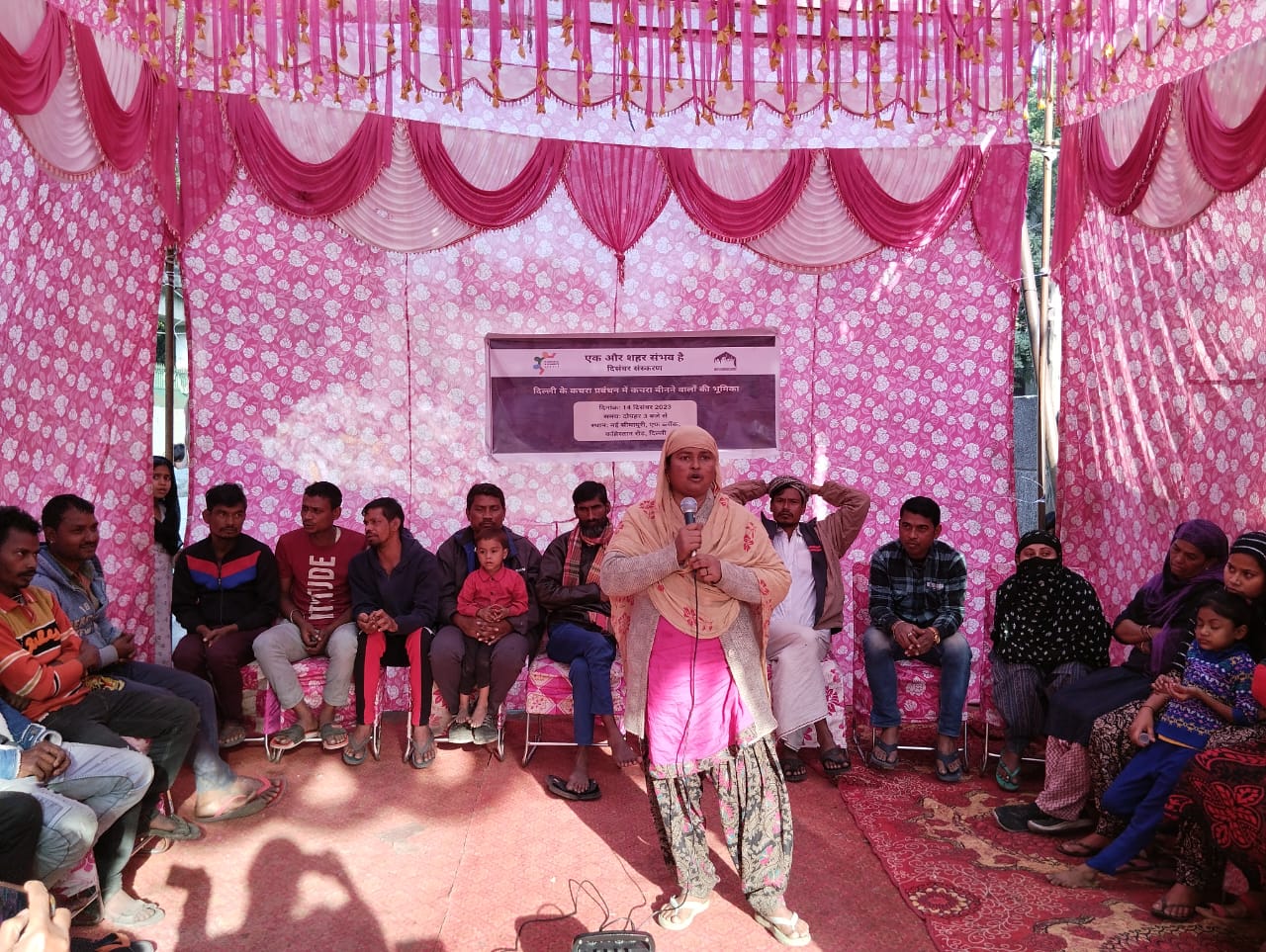Delhi is grappling with a waste crisis, generating 8,000 tons daily. This crisis, primarily a result of management and technical issues, prompted local authorities to engage private companies in 2005. These companies handle collection, transportation, and waste-to-energy incineration at three plants. Public bodies aim to privatise collection and reduce waste volume through incineration, posing concerns for waste recycling workers reliant on recyclable materials for their livelihood.
There are more than 2 lakh waste pickers in Delhi. Most have migrated from other states and entered this profession out of necessity. They have been living off the waste collection and segregation for decades and have immense knowledge of different kinds of waste and their nature. Compared to the familiarity and knowledge regarding waste, their rights over waste (kooda) and their say in the decision-making processes regarding their lives are negligible in the current system.
In the December edition of Another City is Possible, we elaborated upon the role that waste pickers play in the management of waste in the city and the increasing privatisation which has been prevailing in this sector. The event was conducted in the Seemapuri area of Delhi in which stakeholders including waste-pickers themselves, activists and scholars were invited for a round-table discussion. The public meeting was organised in collaboration with “Basti Suraksha Manch.”

Waste in the city

Delhi, the capital of India, with its diverse landscape and dynamic neighbourhoods, pulsates with the lives and livelihoods of more than 3 crore population. The bustling streets and gigantic infrastructure lie at the heart of the city. The three towering mountains of waste that have been produced and reproduced by the city have become a headache for urban planners to tackle. These towering mountains are central to the discourse of building up a ‘world-class’ city. Therefore they become a shame for the Government that promises a ‘clean’ and ‘pollution-free’ city. During every assembly election, the successive government promises to get rid of these garbage mountains.
This colossal city, with its 25 million inhabitants, generates a staggering 8,000 tonnes of Municipal Solid Waste (MSW) every day. The waste management of the city is a colossal task. This mountain of garbage engulfs the city in a sea of socio-ecological hazards. Delhi’s waste management system faces numerous challenges. The sheer volume of waste overwhelms existing infrastructure, with landfills reaching capacity and informal waste pickers often operating in precarious conditions.
Delhi’s battle against waste is not just a local issue but a microcosm of the urban waste challenge faced by cities worldwide. The solutions that emerge from this dynamic metropolis can provide valuable lessons for other urban centres grappling with similar issues.
In the session, Annapurna (Intern, PRC) emphasized that “Waste Management in Delhi is an essential problem which can be solved with consultation with waste pickers of the city that play a crucial role in the waste management of the city.”
Lives & Livelihoods of Waste Pickers

Seemapuri is one of the biggest slums of Delhi with ‘kabadiwalas’ or waste-pickers residing there. Most of the waste pickers here are Muslim migrants who came here after the 1970s cyclone in West Bengal. Their lives and livelihoods face crucial challenges on a day-to-day basis through hardship, vulnerability, and struggle to earn. They play an essential role through their informal networks in the segregation and distribution of waste across the city. Nilma Ji said, “Without us, this city won’t be able to breathe for a day because of the smell of garbage”.
The waste pickers begin their day by collecting waste by doing door-to-door collection of waste in numerous societies of Delhi. The ones residing in Seemapuri cover the nearby areas and even locations like Laxmi Nagar. After collecting the waste, the next step is to segregate the waste into different categories. Dry waste and wet waste are the broad categories but even within dry waste, the waste pickers are skilled in differentiating between 70 types of materials and 11 types of plastics and segregating them. The process of segregation requires an area where the waste can be kept and the waste pickers can sit.
There used to be dalaos before for this purpose which have now been demolished in most places. The streets, roads and even houses of the waste-pickers of Seemapuri are filled with waste as there is no other space available to store and segregate it. This is a major demand of the residents – a space for the segregation of waste, and reinstallment of dalaos. The segregated waste is then available to be sold off to local junk dealer who usually shares social relationships with the waste pickers as well.
The livelihood of waste pickers is precarious and vulnerable. They earn meagre wages, often fluctuating based on the quantity and quality of materials they collect. They face long hours, exposure to hazardous waste, and unpredictable working conditions. The children of the waste pickers often coexist in the spaces where their parents work and aren’t able to go to school even when there are schools in the vicinity. The availability of sanitation and health facilities is also deplorable. Rains bring with them their sanitation problems as the streets and some homes get flooded with wastewater.
Moreover, they are ostracised and marginalised by society because of the social stigma which is attached to them. It was also pointed out in the discussion that “we are also the citizens of this government why is it that government ignores our concern”. Therefore their role in urbanicity is ‘invisible’ to the state.
Their invisibility leads to their exploitation by state personnel such as MCD officers and Police, Middlemen, and several other agents involved in waste management. Therefore during the public meeting, it was emphasised that there needs to be formalisation of the work of wastepickers through a livelihood occupation and identity card.
Transformation of Waste Management practices

Privatisation of management and role of Thekedars
In recent years, waste has been recognised as material and the proliferation of Material Recovery Facility (MRF) Centres has increased. Here, thekedars are given contracts for waste collection by private companies. The waste pickers have to pay an amount to enter these centres and collect waste which can be segregated and sold to junk dealers to earn their livelihood. In addition to the extra amount, sites of waste segregation called dalaos are also demolished leaving only the spaces near the waste pickers homes available for this process.
In Seemapuri an already established ‘dalao’ where waste-pickers used to manage and segregate the waste was stopped and instead a private ‘dalao’ was established. This private waste disposal facility charges Rs 300/day for an entry for segregation of waste which these people can’t afford. In the process, the job of segregation of waste has been taken up by the private companies as well. Hence the essential livelihood of the wastepickers of Seempauri have been snatched away from their hand.
Hence, the roundtable discussion led to the demand for two types of establishment of Waste Disposal Facility – Dry Waste Seggregation Facility and Door to Door Seggregation facilities. Both of which should be handled by waste-pickers. These facilities should have coolers, electricity and toilets and regular maintenance should be done by the MCD. Another major demand that came up was that waste-pickers should directly be able to sell their disposables to authorised dealers instead of the middlemen. The role of middlemen or thekedars in the process of waste management creates several layers of hurdles for waste-pickers to get the due right of their work.
Shabeela ji simply pointed out that these private players and middlemen should be removed from the work they do so that our livelihood gets stabilised.
State’s intervention in waste management practices
The role of the state is important in the waste management process in Delhi. It was pointed out during the discussion that local state officials such as MCD and Police officials harass these waste-pickers. A lot of black money has to be given to these state officials as well for them to continue their work. Therefore the state’s role should be not to harass the waste-pickers instead they should provide them with several benefits.
The demands which were raised were that a Waste Picker Welfare Board along with employment, health insurance, and pensions should be given to waste pickers with Housing Rights as well as post-metric and metric scholarships for the children of waste pickers.
Hence, the role of the state is necessary to facilitate the formalisation of the work of waste-pickers.
The way forward

The systemic exploitation the waste pickers have been subjected to for decades and more so in recent years by the insurgence of privatisation is deplorable. Through this session, we have attempted to formulate a vision of Another City where the conditions and the role of waste pickers are better placed and their demands are heard.
Report prepared by Kislay (Research Assistant) and Annapurna (Intern)

